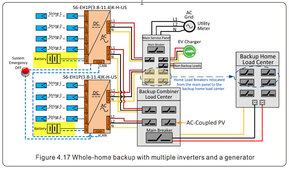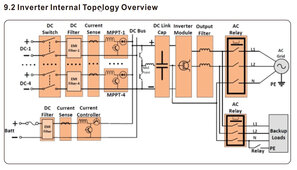Agreed, always follow the manufactures installation requirements and never assume anything can be done just because you have done it before with other equipment.
That's exactly the point of me reviewing this thread. Every single manufacturer of these new cheap AIOs implies their LV battery inputs are non-isolated (by putting a huge warning about grounding any battery terminal). Sadly just asking them is the worst thing you could do. I recently asked my "manufacturer" about a cooling issue with an inverter. I sent them a picture showing transparent air ducting inside and I asked if something is not missing. You know what they replied...
"um, don't need this plastic.[Sweat]". Completely clueless... If the goal was for this to be the last tech question I asked, they achieved it.
The two in operation now are both PowMr POW-LVM-24V-H.
Great. I checked, the manufacturer says "no parallel capability". This is very useful.
I previously was running 2 EAsuns 3kW units of similar SRNE manufacture but lower PV voltage capability.
Did you have them connected like this too? Do you perhaps remember which EASUNs were they? (this is of special interest to me as I have an EASUN SMH-ii).
Total run time for me is near over 1.5 years with the two AIO's and the last month I added a Ampinvt 5kW Low Frequency Inverter charger that is not being used as charger, strictly battery to split phase output. Also in the mix is a 3rd PV array that feeds the battery from another SCC plus a wired in 12a AC to DC battery charger that is used on a timer circuit for overnight addition if conditions warrant.
Nothing untoward has been noted doing this.
This is very valuable info for anyone looking for an answer. Thank you.
If the AC of two inverters are not connected, then what's the problem? The DC battery doesn't see the AC.
Note: The Inverter does switch on and off draw from the battery. That is what the inverter's capacitors are for. Smooth out draw/voltage from the battery.
This is the key to understanding what I'm talking about. The Inverter exactly switches on and off it's connection to the battery as you said. It does so very quickly with timing depending on its control loop. The other end of this "switch" is connected to inverter's internal high voltage DC bus (~400V).
So how does the low battery voltage gets boosted to 400V?
There are various designs, but the simplest also has an inductor in series with "the switch". Long story short when you do this and you "switch on" the inductor charges up - a bit like a capacitor. Then when you switch off it tries to continue pushing the same current raising the voltage. By controlling the timing, capacitance and inductance you control the voltages and currents. And we haven't even started talking about charging - it's the same circuit that does this, so current can flow in or out. Now imagine you have two such circuits with completely unsynchronised switching messing with eachother.
I'm not saying that's what happens as
@MattB above has been running the types he's got for some time. I'm just saying there is possibility of problems so we better gather the reports from people that do run like this with makes and models of their inverters to be sure.
@SeaGal 's experience with the 100ohm resistor is enough to show that no, it is not "as simple as loads and chargers".
There are many AIO designs out there. The pdf I attached shows 5 most common non-isolated ones. Putting out a blanket statement like "all of them are fine to parallel on the battery side, it's just loads and chargers" without saying something like "I've been installing them in parallel for years" and list some types. Or taking one if these common designs and justyfying using EE principles is just dangerous.
And answering a question how do you know something with "years of experience"(unless you're a designer of said AIOs, or an EE university professor) is a huge red flag to take anything else said with a (large) grain of salt.
You can't power a load without a "completed" circuit.Connect a load, and you can confirm this for yourself.
When the switching elements in the DC converters are on there is a complete circuit.
High voltage batteries in parallel inverter systems are a completely different animal.
Indeed, but here is an example of one that is parallell both on AC and DC side from Deye (HV battery).

What does this prove? That there are kinds of HV inverters that can and cannot share the same battery - at least among ones that can be parallel'ed on the AC side.
But this thread is really about low cost low voltage
non-isolated AIOs with no parallel function on the AC side. So no Deye etc, and no HV.







